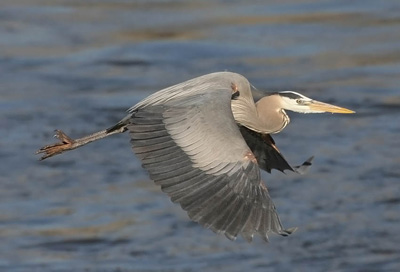|
back Home Life Along a
|
|
Great Blue Heron
Ardea herodias|
© Jim Arterburn, www.pbase.com/oklahomabirder |
With its long legs and neck, the Great Blue Heron is a tall, bluish-grey wading bird standing 1.5 m high. When flying, the long neck is folded in an S-shape, the long legs extend along body, and the long, rounded wings make slow wingbeats. This heron nests mostly in colonies, sometime with several hundred other pairs. Colonies are often located on islands and in wooded swamps; these isolated locations discourage nest predation by snakes and mammals. The great blue heron eats mostly fish, but also amphibians, reptiles, birds, mammals, and invertebrates. During the winter it may hunt in upland fields for rodents. However, these herons typically hunt fish and other aquatic animals while wading in shallow water. The Great Blue Heron is one of the most widespread and adaptable wading birds in North America. Found year round throughout the US, some will migrate north in summer to southern Canada, and migrate south to Central and South America in the winter. This heron lives in both coastal and fresh water habitats. In Oklahoma, you are likely to observe herons in and along any body of water: rivers, lakes, wetland and even in roadside ditches and suburban ponds. |
|
back to species list |
PDF of all species profiles
|

